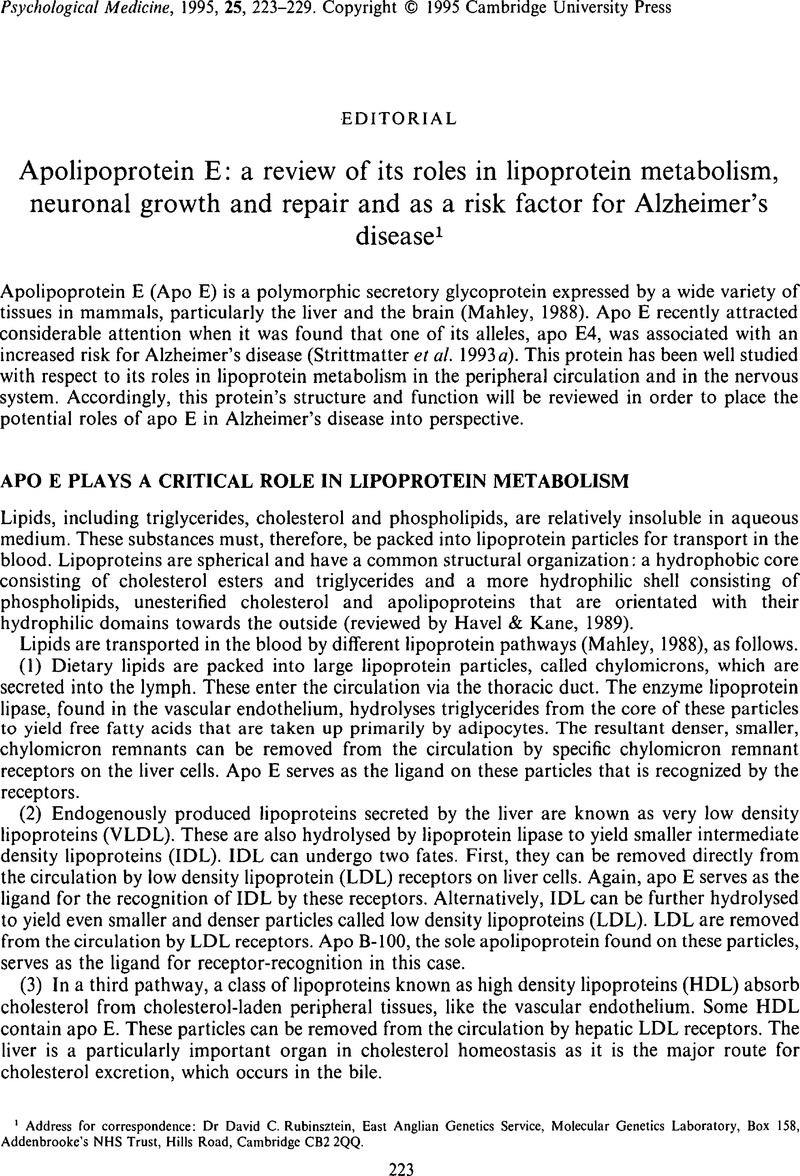Crossref Citations
This article has been cited by the following publications. This list is generated based on data provided by Crossref.
Thome, J.
Baumer, A.
Kornhuber, J.
Rösler, M.
and
Riederer, P.
1995.
Alpha-1-antichymotrypsin bi-allele polymorphism, apolipoprotein-E tri-allele polymorphism and genetic risk of Alzheimer's syndrome.
Journal of Neural Transmission - Parkinson's Disease and Dementia Section,
Vol. 10,
Issue. 2-3,
p.
207.
Kwon, Younga J.
Tsai, Julia
and
Relkin, Norman R.
1996.
Bibliography NIA/AlzA Conference on Apolipoprotein E Genotyping in Alzheimer's Disease.
Annals of the New York Academy of Sciences,
Vol. 802,
Issue. 1,
p.
177.
Tysoe, Carolyn
Galinsky, Daliah
Robinson, Damian
Brayne, Carol E.
Easton, Douglas F.
Huppert, Felicia A.
Dening, Tom
Paykel, Eugene S.
and
Rubinsztein, David C.
1997.
Analysis of alpha-1 antichymotrypsin, presenilin-1, angiotensin-converting enzyme, and methylenetetrahydrofolate reductase loci as candidates for dementia.
American Journal of Medical Genetics,
Vol. 74,
Issue. 2,
p.
207.
Rubinsztein, David C.
1997.
The genetics of Alzheimer's disease.
Progress in Neurobiology,
Vol. 52,
Issue. 6,
p.
447.
Rutter, Michael
1997.
Implications of Genetic Research for Child Psychiatry.
The Canadian Journal of Psychiatry,
Vol. 42,
Issue. 6,
p.
569.
Hochstrasser, Denis F.
Frutiger, Séverine
Wilkins, Marc R.
Hughes, Graham
and
Sanchez, Jean-Charles
1997.
Elevation of apolipoprotein E in the CSF of cattle affected by BSE.
FEBS Letters,
Vol. 416,
Issue. 2,
p.
161.
Galinsky, Daliah
Tysoe, Carolyn
Brayne, Carol E.
Easton, Douglas F.
Huppert, Felicia A.
R. Dening, Thomas
Paykel, Eugene S.
and
Rubinsztein, David C.
1997.
Analysis of the apo E/apo C-I, angiotensin converting enzyme and methylenetetrahydrofolate reductase genes as candidates affecting human longevity.
Atherosclerosis,
Vol. 129,
Issue. 2,
p.
177.
Fields, Robert B.
1997.
Handbook of Neuropsychology and Aging.
p.
280.
Jorm, Anthony F
1997.
Alzheimer's disease: risk and protection.
Medical Journal of Australia,
Vol. 167,
Issue. 8,
p.
443.
Lethem, Rosemary
and
Orrell, Martin
1997.
Antioxidants and dementia.
The Lancet,
Vol. 349,
Issue. 9060,
p.
1189.
Powchik, Peter
Friedman, Joseph
Haroutunian, Vahram
Greenberg, David
Altsteil, Larry
Purohit, Dushyant
Perl, Daniel
and
Davidson, Michael
1997.
Apolipoprotein E4 in schizophrenia: A study of one hundred sixteen cases with concomitant neuropathological examination.
Biological Psychiatry,
Vol. 42,
Issue. 4,
p.
296.
Pasquier, F.
Leys, D.
and
Scheltens, P.
1998.
Alzheimer’s Disease — From Basic Research to Clinical Applications.
Vol. 54,
Issue. ,
p.
117.
Plotnin, Robert
and
Rutter, Michael
1998.
Child Development, Molecular Genetics, and What to Do with Genes Once They Are Found.
Child Development,
Vol. 69,
Issue. 4,
p.
1223.
Marmillot, Philippe
Rao, Manjunath N.
Liu, Qing-Hong
and
Lakshman, M.Raj
1999.
Desialylation of human apolipoprotein E decreases its binding to human high-density lipoprotein and its ability to deliver esterified cholesterol to the liver.
Metabolism,
Vol. 48,
Issue. 9,
p.
1184.
Holland, A. J.
2000.
Ageing and learning disability.
British Journal of Psychiatry,
Vol. 176,
Issue. 1,
p.
26.
Anderson, George M.
and
Cook, Edwin H.
2000.
Pharmacogenetics: Promise and Potential in Child and Adolescent Psychiatry.
Child and Adolescent Psychiatric Clinics of North America,
Vol. 9,
Issue. 1,
p.
23.
de-Andrade, F.M.
Larrandaburu, M.
Callegari-Jacques, S.M.
Gastaldo, G.
and
Hutz, M.H.
2000.
Association of apolipoprotein E polymorphism with plasma lipids and Alzheimer's disease in a Southern Brazilian population.
Brazilian Journal of Medical and Biological Research,
Vol. 33,
Issue. 5,
p.
529.
Plomin, R.
2001.
International Encyclopedia of the Social & Behavioral Sciences.
p.
7645.
Retz, W.
Thome, J.
Durany, N.
Harsányi, A.
Retz-Junginger, P.
Kornhuber, J.
Riederer, P.
and
Rösler, M.
2001.
Potential genetic markers of sporadic Alzheimerʼs dementia.
Psychiatric Genetics,
Vol. 11,
Issue. 3,
p.
115.
Park, C.R
2001.
Cognitive effects of insulin in the central nervous system.
Neuroscience & Biobehavioral Reviews,
Vol. 25,
Issue. 4,
p.
311.



